How to Grow Cauliflower Like a Farmer for Giant Harvests
Author: Jen Worst | Editor: Omar Alonso
Review & Research: Jen Worst & Chris Miller
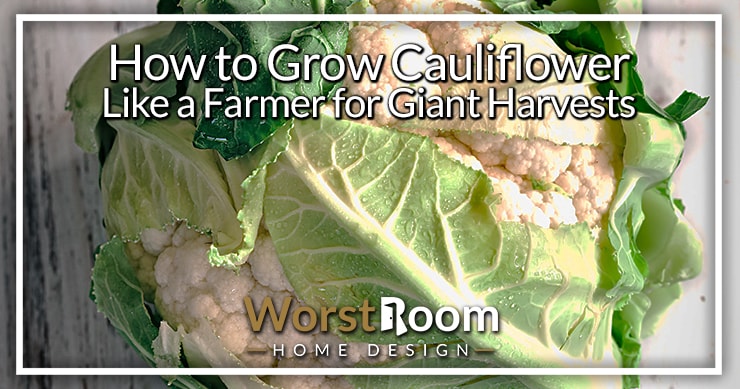
Knowing how to grow cauliflower isn't difficult at all. The real challenge is the patience it takes and the discipline to water and feed your garden without an immediate reward of a huge harvest. But it's coming if you do your part!
One of the fancier members of the cabbage family, cauliflower are a big favorite among gardeners in cool zones and an even more popular on dinner plates worldwide.
Many folks love the nutty texture of the vegetable, similar in flavor to broccoli, as well as its versatility—cauliflower rice, mock mashed potatoes, cauliflower popcorn, or even puree, this edible flower can be enjoyed in many ways and acts as a healthy substitute for many vegetables, leading to a rise in its ranks among vegans and fitness enthusiasts alike.
Though these plants are quite sensitive to temperature changes and are not the easiest vegetables to grow, the end product is well worth the effort.
You can even grow it with other crops such as the types of kale, turnips, and broccoli you love, so you’re not completely back to square one if your cauliflower crop fails.
Scientifically known as brassica oleracea, all types of cauliflower are a rich source of fiber, antioxidants, choline, and a range of other nutrients. The vegetable also acts as a low-carb substitute for many legumes and grains.
Unilke so many other domesticated crops, cauliflower's cultivation is fairly recent. The earliest known usage is around the 15th century (and it was never mentioned in Middle Age literature, corroborating this fact). If you want to invest the resources in growing cauliflower, here’s a guide on doing it the right way.
How to Grow Cauliflower
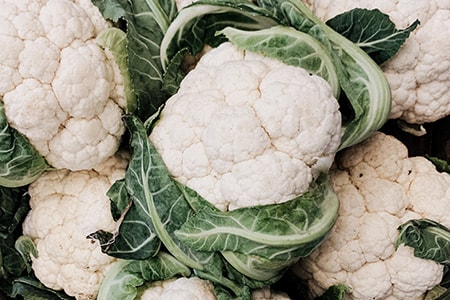
Cauliflowers grow well in cool weather and are half-hardy biennial plants grown as annual crops. The head of the cauliflower (also called a ‘curd’), formed of clusters of edible buds seated on single stalks, can be white, green, purple, or cream in color.
Purple varietiess get their color from the antioxidant anthocyanin whereas some farmers cross broccoli and cauliflower to get the broccoflower with its green head. Sometimes, thanks to a high percentage of beta-carotene (the same stuff that all the types of carrots have), orange varieties become a reality.
Let's dive into growing this vegetable. We'll start at the growing conditions the act of knowing how and when to plant cauliflower, on to helping them thrive, and then getting a big harvest.
Growing Cauliflower - Conditions to Thrive
Cauliflowers, as mentioned earlier, thrive in cool weather. These plants require anywhere between 55 to 120 days of even, cool temperatures to be ready for harvesting, depending on whether you’re planting seeds or transplants.
Seeds take between 70 to 120 days to mature whereas transplants mature quicker, taking 55 to 80 days.
The ideal soil temperature should be between 65 to 75 degrees Fahrenheit (which is easily achievable in cool weather). Additionally, the soil needs to be well drained, moisture retentive, and nutrient rich (adding aged compost in the plant beds before planting helps), with a pH level between 6.5 to 8.
Though cauliflowers are cool-weather plants, they grow best in full sun, though a little shade might help in keeping the plants from budding or bolting—a process where the plant shifts focus to producing seeds and flowers rapidly in order to survive, becoming bitter and inedible in the process.
When to Plant Cauliflower
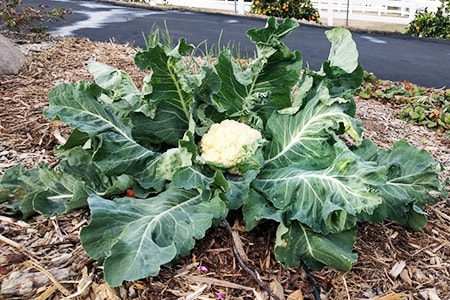
More folks, professional farmers included, prefer to use transplants over seeds to plant and grow cauliflowers, as the former matures faster and is easier to grow.
If you prefer using seeds, start by sowing them 4 to 5 weeks before the last spring frost date. Start them indoors and use peat or paper pots since cauliflowers don’t take too well to their growth and roots getting disturbed in the growing process.
With a soil warmth between 65-70 degrees Fahrenheit, sown half-inch deep and kept moist, your seeds will grow well. Leave at least 3 to 6 inches of space between each seed.
Once the seeds have germinated (they start to germinate at around 45 degrees Fahrenheit) and sprouted and you have small plants on hand, transplant them into your garden at least two to four weeks before the last spring frost date (don’t delay or advance this too much).
If you’re using transplants (the more recommended option) to grow cauliflowers, these can be planted in the garden two to six weeks before the last frost—this is generally six weeks following the sowing, when the plant has at least 4 to 5 “true” leaves. As mentioned earlier, the soil needs to be between 65 and 75 degrees Fahrenheit and the weather cool.
Planting Cauliflower
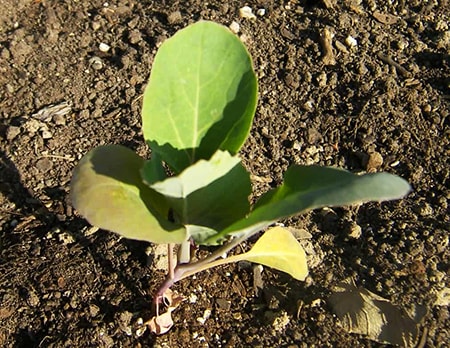
Set transplanted cauliflower plants at least 18 to 24 inches apart, leaving at least 30 inches between the rows. It’s a good idea to plant transplants deeply, setting them as deeply as their first leaves, to prevent them from growing top heavy.
If you’re looking for a fall crop, plant the crop at least 6 to 8 weeks (for transplants) or 8 to 12 weeks (for seeds) before the first fall frost date, but while ensuring that temperatures during the day are consistently below 75 degrees Fahrenheit. Don’t forget to make provisions for shade, if required!
If the soil gets too dry, add sufficient mulch to keep the soil most—just as they don’t tolerate temperature extremes and fluctuation, these plants detest dry conditions and will bolt or seed in such conditions.
For winter harvest, plant cauliflowers in autumn—this will work only in areas where winters are mild and free of frost.
Come early spring, you may have to protect your plants from the frost—you can cover them up with a range of objects, old milk jugs included. Covering them is important, since the extreme cold and weather fluctuation can stop your cauliflowers’ growth or lead to the formation of buttons.
How Far Apart to Plant Cauliflower
Cauliflower transplants should be planted 18 to 24 inches apart with 30 inches between rows. Cauliflower seeds should be planted with 3 to 6 inches between them until they are large enough to be transplanted.
Caring for Cauliflower During Growth
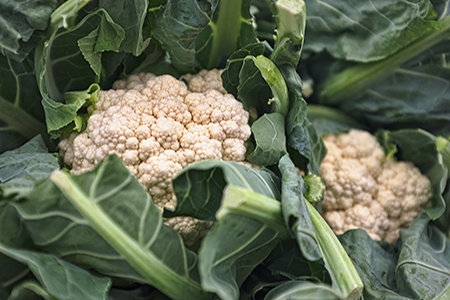
The plants require plenty of water to grow and consistently. The heads can start seeding and grow bitter, without the necessary amount of water. Like most plants, the key to how to grow cauliflower is water.
At least an inch of water per week should be provided and this must soak at least six to eight inches into the soil to ensure that your veggie gets the right nutrition.
Additionally, the combination of dry soil and hot weather will result in the buds opening slightly—this will lead to the formation of “ricey” heads, instead of tight, delectable curds. As mentioned earlier, mulching while planting will keep the soil cool and wet enough.
Owing to their relatively long maturity period, you may also need to feed your plants supplemental feed, such as kelp, fish emulsion, and other organic fertilizers, every 2 to 4 weeks. For help understanding them, please refer to our guide on the N-P-K numbers on fertilizer.
If you’re growing white cauliflowers, bear in mind that they will need to be “blanched” or covered to prevent color from developing. This is what gives the cream colored varieties their color.
Additionally, blanched cauliflowers are much sweeter (and better looking!) than their natural yellowish-brown counterparts.
Start blanching the heads when the plant reaches the size of a large egg. Ensure that the plants are fully dry, so that no rotting occurs. You can traditionally blanch the cauliflowers by folding the larger leaves over the head and tucking/securing them.
Use a rock to keep the leaves in place, or tie them to hold them in place, but ensure that you’re not tying or securing them too tightly—you need to block the light but allow enough room for the head’s expansion.
Once you’ve done this, keep checking under the leaves so that no nasty pest surprises await you and try to keep the leaves as dry as possible.
For a non-traditional blanch, all you have to do is cover the cauliflower with an old jug, bucket, or any container. If all this sounds like too much work, just grow a colored cauliflower—not only do these not require blanching, but they’re also tastier!
When to Harvest Cauliflowers
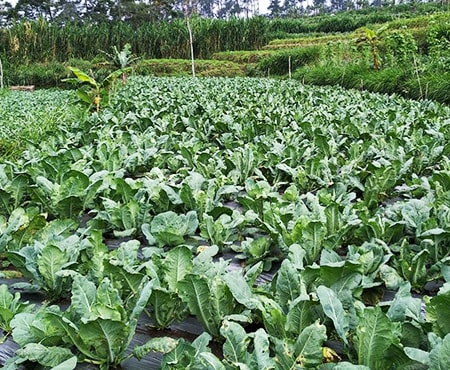
Cauliflowers can take between 2 to 3 months to mature, depending on the variety. Ensure that whichever variety you do pick matures in your area’s climate, since the heads won’t form in the warmth and the plants can only handle light frosts.
Therefore, for a short fall or spring, pick a variety that matures fast. If you’re blessed with late or mild winters, you have the option of growing a variety that takes its time to mature. Generally, in cold climates, sowing transplants in mid or late summer, with a fall harvest, works well.
Harvest your cauliflowers when the buds are still tight and the heads are at the desired size. Don’t wait till the flowers open. This is the final step of the how to grow cauliflower guide that maximizes the quality of your crop.
Additionally, you can freeze the cauliflowers after harvesting them at maturity and store them for later use, or lift the whole plant—roots, stem and all—and store it in a cool, dry place.
Cauliflower Pest & Disease Problems
As with any plant, cauliflowers, too, have their share of pest problems. Cauliflowers, sadly, are vulnerable to the usual pest suspects, including cabbage worms among other types of worms, maggots, and loopers. Young plants also attract flea beetles and aphids, especially in the spring.
Another pest that cauliflowers attract—groundhogs! A fence or cage around your garden will help keep these away.
Apart from these pests, cauliflowers are also susceptible to black rot, clubroot, and blackleg, among other diseases—you can prevent this by cleaning all debris at the season’s end and not planting cole crops in the same place continuously over the years.
Leaf-tip dieback and distortion are also common problems that kelp seaweed fertilizer can solve.
That's How to Grow Cauliflower!
Cauliflowers require some care and love while growing, but are definitely worth the result. If you don’t want to put all your eggs in one basket, you can grow cauliflowers with celery, all types of beets, onions, herbs and potatoes; avoid tomatoes, strawberries and pole beans.
Additionally, if you want to save seeds, leave some of your crops unharvested over the winter, protecting them sufficiently from the cold.
Keep our how to grow cauliflower guide in mind and you’ll be an expert farmer in no time!



